Bulletin – March 2010 Recent Developments in Banks' Funding Costs and Lending Rates
- Download the article 241KB
Abstract
The global financial crisis has affected the cost and composition of Australian banks' funding, with flow-on effects to their lending rates and net interest margins. Since mid 2007, Australian banks' overall funding costs have risen significantly relative to the cash rate, mainly reflecting the higher cost of deposits and long-term wholesale debt, and changes in their funding mix. Australian banks' lending rates have also risen significantly relative to the cash rate. For the major banks, the increases in lending rates have more than fully offset their higher funding costs, with their net interest margins in late 2009 about 20–25 basis points above pre-crisis levels. Since then, margins may have narrowed slightly.
Introduction
Australian banks raise funding from deposits and in capital markets so their funding costs, and consequently lending rates, are affected by financial market conditions. For several years up until mid 2007, with market conditions and spreads stable, banks' overall cost of funds tended to follow the cash rate, and therefore banks tended to adjust their lending rates mainly in response to changes in the cash rate. Since then, the global financial crisis has pushed up banks' funding costs relative to the cash rate and this has been reflected in their lending rates. This article updates previous Reserve Bank research on banks' funding costs.[1] The article notes that banks' overall funding costs remain significantly higher relative to the cash rate than they were in mid 2007, mainly due to the large increases in the cost of deposits and long-term wholesale debt, and a shift in banks' funding mix towards these more expensive, but typically more stable, types of funding.
Banks' lending rates have also risen relative to the cash rate. The increases have been largest for business and personal loans, in part reflecting a reappraisal of risk on this lending during the recent slowdown in the Australian economy, and smallest for variable-rate mortgages. The bulk of the increases occurred during 2008 and early 2009.
Most of the increase in banks' lending rates over the cash rate since mid 2007 has been due to their higher funding costs. For the major banks, however, there has also been an increase in their net interest margins (NIMs), which in late 2009 were about 20–25 basis points above pre-crisis levels. The major banks' higher NIMs have supported their return on equity, partly offsetting the negative effects of the cyclical increase in their bad debts expense and the additional equity that they raised during the downturn. The regional banks' NIMs have declined steadily for much of the crisis period, mainly reflecting the larger increase in their funding costs, though recently they have risen a little.
Composition of Banks' Funding
Banks operating in Australia have diverse funding bases, with most funding sourced from deposits, short-term and long-term wholesale debt. The funding mix differs somewhat across banks, however, with the major banks having a slightly larger share of deposit funding than the banking system as a whole and relying very little on securitisation (Table 1). Regional banks generally have more deposits and make greater use of securitisation and less use of offshore funding, while foreign-owned banks have less deposits and correspondingly more funding from domestic capital markets and offshore.
| June 2007 | January 2010 | |
|---|---|---|
| Major Banks | ||
| Domestic deposits | 43 | 48 |
| Short-term wholesale debt(b) | 24 | 18 |
| Long-term wholesale debt | 21 | 25 |
| Equity | 7 | 8 |
| Securitisation | 5 | 1 |
| Regional banks | ||
| Domestic deposits | 39 | 47 |
| Short-term wholesale debt(b) | 23 | 14 |
| Long-term wholesale debt | 10 | 17 |
| Equity | 11 | 13 |
| Securitisation | 17 | 9 |
| Foreign-owned banks | ||
| Domestic deposits | 27 | 24 |
| Short-term wholesale debt(b) | 58 | 58 |
| Long-term wholesale debt | 11 | 16 |
| Equity | 2 | 2 |
| Securitisation | 2 | 0 |
|
(a) The classification of individual banks into major, regional and foreign-owned
banks is the same in both periods, and is based on their classification
in January 2010. Hence the changes in funding composition are unaffected
by the recent merger and acquisition activity in the Australian banking
sector.
Sources: APRA; RBA |
||
The funding mix of banks in Australia was fairly stable during the few years leading up to the onset of the global financial crisis in mid 2007. However, the financial crisis has had a significant impact on the relative cost of banks' various funding sources. Globally, it has also led to a renewed focus on the composition of banks' funding. As a result, banks in Australia have increased their use of deposits and long-term debt, as these funding sources are perceived to be relatively stable, and reduced their use of short-term debt and securitisation.
The share of funding that comes from deposits for all banks in Australia has risen by 3 percentage points since mid 2007 to 42 per cent, with most of this increase occurring during the height of the financial crisis in 2008 and early 2009 (Graph 1). Term deposits have accounted for most of the growth in banks' deposit funding. The regional banks have had the largest rise in deposit funding, while the major banks have also increased their use of deposit funding. In contrast, the foreign-owned banks have experienced a fall in the proportion of funding coming from domestic deposits. Looking forward, it is not clear that there is much additional scope for the banking system as a whole to materially increase its use of deposit funding. Over the past year, the share of deposits in the total funding of banks in Australia has been little changed, even though banks have been offering very high interest rates to try to attract additional deposits.
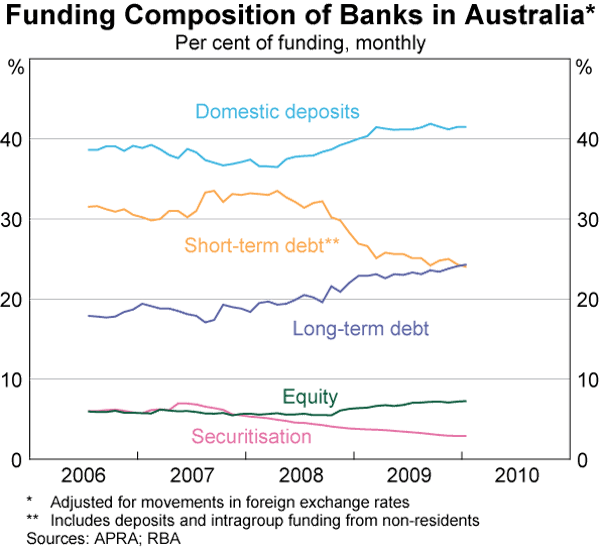
The share of funding sourced from long-term wholesale debt (domestic and foreign) for the overall banking system has increased by 6 percentage points since mid 2007 to about 24 per cent, with all of the main groups of banks increasing their use of this funding source. During late 2008 and the first half of 2009 the banks mainly issued government-guaranteed bonds, but as market conditions have improved they have increasingly issued unguaranteed bonds.[2]
Short-term wholesale debt (domestic and foreign) currently accounts for about 24 per cent of banks' funding; this is down from a little over 30 per cent in mid 2007.
The share of banks' funding that is from securitisation has halved to 3 per cent over the course of the financial crisis, as outstanding residential mortgage- backed securities (RMBS) have continued to amortise and there has been very little new issuance. This downward trend may start to change during 2010, as there have recently been signs of improvement in the cost and availability of securitisation funding.
The major and regional banks have also bolstered their balance sheets by raising equity, through a combination of retained earnings and sizeable share placements in late 2008 and during 2009. For the banking system, the share of equity in total funding liabilities has increased by 1 percentage point since mid 2007 to about 7 per cent.
Cost of Funding
The cash rate still has a large influence on banks' funding costs. However, the global financial crisis and its ongoing effects have caused the costs of all of the banks' main sources of funding to rise relative to the cash rate and relevant money market rates. The increases have been particularly large for deposits and long-term wholesale debt. The shift in banks' funding mix towards these typically more stable, but also more expensive, sources has also contributed to the rise in their overall funding costs.
Deposits
Competition for deposits in Australia has intensified over the past two years, resulting in a significant increase in deposit rates relative to market benchmark rates. Overall, it is estimated that the average cost of the major banks' new deposits is currently slightly higher than the cash rate, compared with about 150 basis points below the cash rate prior to the onset of the financial crisis (Graph 2). The regional banks have likely seen a slightly larger increase in their deposit costs, reflecting their greater use of term deposits.
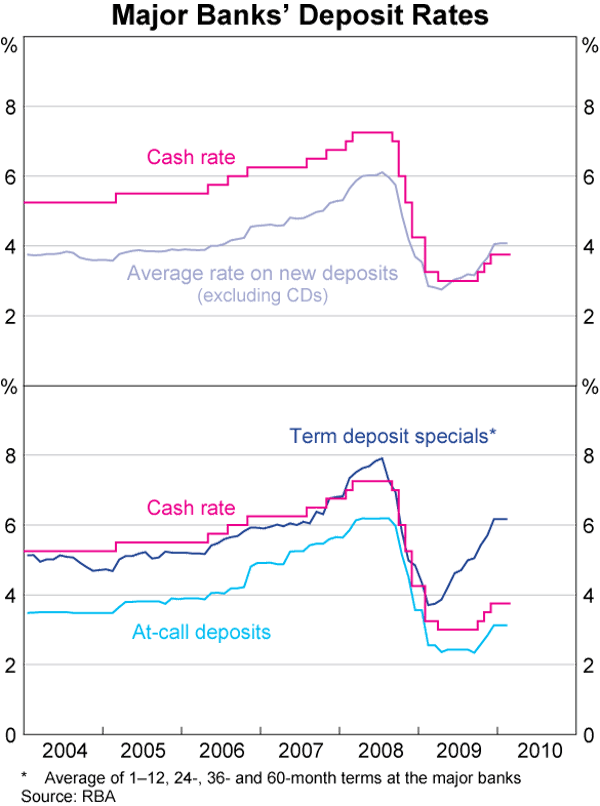
Within the deposit market, competition has been strongest for term deposits, which account for about 40 per cent of the major banks' deposits and about 55 per cent of the regional banks' deposits. The average rate on banks' term deposit specials – the most relevant rate for term deposit pricing – is currently about 140 basis points above money market rates over equivalent terms, whereas in the few years prior to the global financial crisis it was generally about 60 basis points below it. The banks have been offering significantly higher rates across all of their term deposit specials, from 1 month to 5 years. For the major banks, their rates on 3- and 5-year term deposits are currently 30–100 basis points higher than the yields on their unguaranteed bonds of equivalent maturity (Graph 3). For the regional banks, the interest rates on their longer-term deposits are estimated to be still a little below the yields on their unguaranteed bonds, as the spreads on their bonds are higher. The banks' aggressive pricing of term deposits partly reflects a view that they are a reasonably stable source of funding and that the fixed rates on individual term deposits allow banks to offer high interest rates to attract new deposits without immediately repricing their existing deposit base.[3]
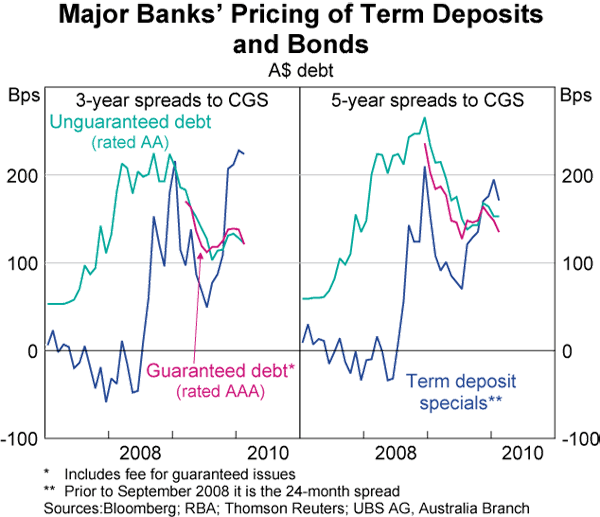
Rates on at-call savings deposits – including bonus saver, cash management and online savings accounts – have also risen relative to the cash rate (from which these deposits are priced). The average rate on the major banks' at-call deposits, which account for a little under half of their total deposits, is currently around 60 basis points below the cash rate, compared with around 100 basis points below in mid 2007. The major banks have also started offering higher introductory rates on some of their at-call accounts to attract new customers. These introductory rates are often well above the cash rate, although they typically only last for a few months.
Wholesale debt
The higher cost of long-term wholesale debt funding has also made a significant contribution to the overall rise in banks' cost of funds. For several years up to mid 2007, the major banks were typically able to issue 3-year bonds in Australia and offshore at an overall spread (including the hedging costs on foreign currency debt) of 10–20 basis points over bank bill or swap rates (Graph 4).[4] However, primary market spreads on banks' bonds have risen significantly, as greater risk aversion has seen investors demand larger risk premia to provide term funding to banks. The cost of hedging foreign currency debt back into Australian dollars has also been high and volatile. The overall cost to the major banks of issuing new 3-year bonds peaked in early 2009 at about 170 basis points over bank bill or swap rates for debt issued in Australia and about 200 basis points for debt issued offshore. The improvement in capital market conditions over the past year has seen the cost of issuing new debt decrease to about 80–120 basis points.
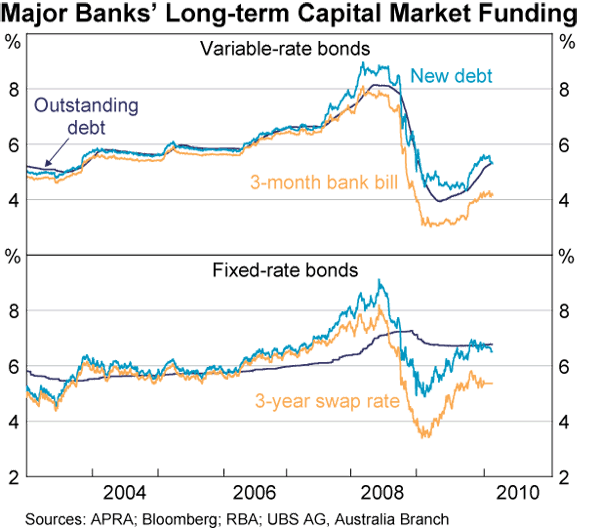
The average cost of the major banks' outstanding long-term debt is estimated to have risen by less – about 100 basis points relative to money market rates – as the higher spreads described above only affect banks' new bond issuance, not their outstanding stock of debt that was issued prior to the onset of the financial crisis. If bond spreads and hedging costs remain around their current levels, then as maturing bonds are rolled over, the average spread on banks' outstanding long-term debt is estimated to increase by about 30 basis points over the next year and a half and broadly stabilise thereafter.
The regional banks, which are smaller and have lower credit ratings than the major banks, have experienced an even larger increase in the cost of long-term wholesale debt, but it is a smaller share of their total funding. Prior to the onset of the financial crisis, regional banks were able to issue 3-year bonds at an estimated overall spread of about 30–50 basis points over bank bill or swap rates. However, the overall cost to the regional banks of issuing new unguaranteed 3-year bonds is currently about 200–250 basis points, and was considerably higher at the peak of the financial crisis.
Short-term wholesale debt accounts for about one-quarter of banks' funding, and is priced mainly off 1- and 3-month bank bill rates. Prior to mid 2007, bank bill rates closely tracked the market's expectation for the cash rate (the overnight indexed swap or OIS rate) with the spread between 3-month bank bills and 3-month OIS remaining stable at around 10 basis points (Graph 5). The onset of the global financial crisis saw bank bill rates rise well above OIS rates, with the spread peaking at about 100 basis points in October 2008. Due to the short maturity of this debt, these higher spreads flowed quickly through to banks' funding costs. Through 2009, however, the sizeable risk premia that were evident in bank bill rates for much of the previous two years largely dissipated. Hence, major banks' short-term capital market debt is currently only about 15–20 basis points more costly relative to the market's expectation for the cash rate than it was in mid 2007, and is adding little upward pressure to banks' overall funding costs compared with other sources. For the regional banks, the increase in the cost of short-term debt has been slightly larger.
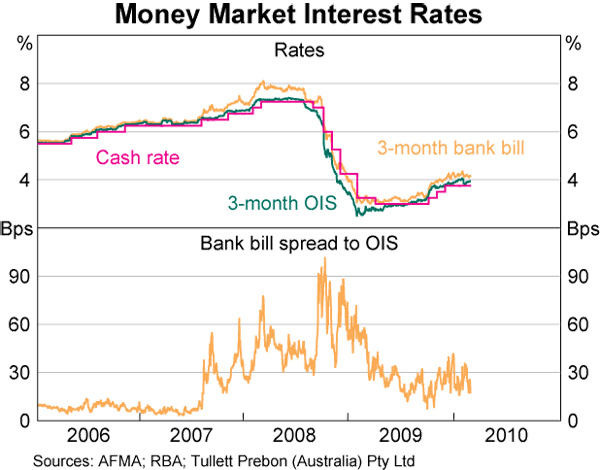
RMBS account for only a small share of the major banks' funding, but are reasonably important for the smaller financial institutions. The cost of new securitisation funding (but not existing funding) has risen significantly since the onset of the global financial crisis and new issuance was scarce between mid 2007 and mid 2009, as demand from private investors fell away (Graph 6).[5] Much of the issuance by Australian entities during late 2008 and early 2009 was purchased by the Australian Office of Financial Management (AOFM) under a Government plan to support securitisation and so smaller housing lenders. Since mid 2009, however, the securitisation market has started to recover, with the volume of issuance to private investors picking up and spreads narrowing noticeably. Spreads on RMBS are similar for the different types of banks (and also for non-banks). This means that securitisation is relatively more cost-effective for the smaller banks, given that spreads on their on-balance sheet wholesale debt (particularly long-term debt) are much higher than for the major banks. Overall, securitisation is once again a viable funding option for lenders, and going forward, it is likely that they will increase their use of this source.

The major and regional banks also issued a significant amount of new equity and hybrid securities during late 2008 and 2009 to further strengthen their balance sheets and support lending growth. This additional capital was expensive for the banks, as their share prices were reasonably low through much of this period, and spreads on hybrid securities have increased markedly since mid 2007. While this has had only a modest impact on overall funding costs given their small shares in total funding, it has contributed to the recent decrease in their return on equity.
Overall funding costs
Taking into account the costs of individual funding sources noted above, and weighting them by their share of total bank funding, allows an estimate of the overall change in banks' funding costs. It is estimated that the average cost of the major banks' funding is about 130–140 basis points higher relative to the cash rate, than it was in mid 2007 (Graph 7). Most of the increase in the major banks' funding costs occurred during 2008 and early 2009 when the financial crisis was at its worst. Since mid 2009, the major banks' overall funding costs are estimated to have risen only a little more than the cash rate. The higher cost of deposits has made the largest contribution to the overall increase, reflecting their large weight in total funding and the 160–165 basis point rise in deposit rates. Long-term wholesale debt has also made a substantial contribution to the increase in the major banks' overall funding costs, while the cost of short-term wholesale debt initially rose but is now much closer to pre-crisis levels.
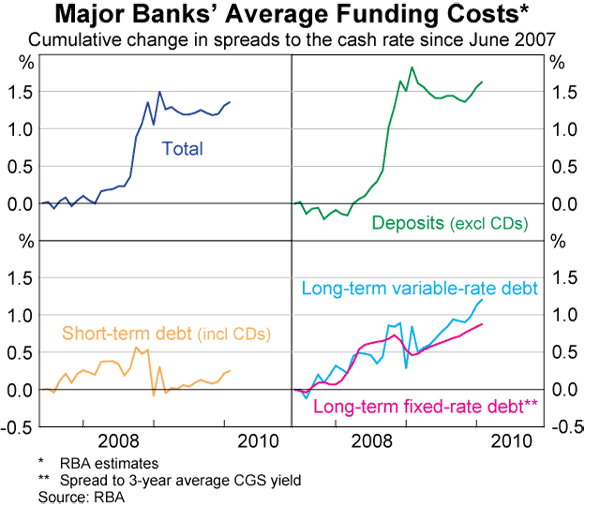
The available evidence suggests that the overall increase in the regional banks' funding costs since the onset of the financial crisis has been larger than that experienced by the major banks. This mainly reflects the bigger rises in the cost of the regional banks' deposits and wholesale debt funding and the shift in their funding mix from securitisation to deposits, which is currently a relatively expensive source of funding.
Banks' Lending Rates and Margins
In setting interest rates on loans, banks take into account changes in their overall cost of funds. For a number of years prior to the global financial crisis, banks' overall cost of funds followed the cash rate reasonably closely as risk premia in markets were low and stable, and therefore banks tended to adjust their lending rates mainly in response to the cash rate. The relationship between the cash rate and the banks' indicator rates on variable housing and small business loans was particularly close from 1998 to 2007, though the average actual rates paid by housing and business borrowers declined a little relative to the cash rate during this period (Graph 8). Before then, however, banks' lending rates did not follow the cash rate particularly closely.
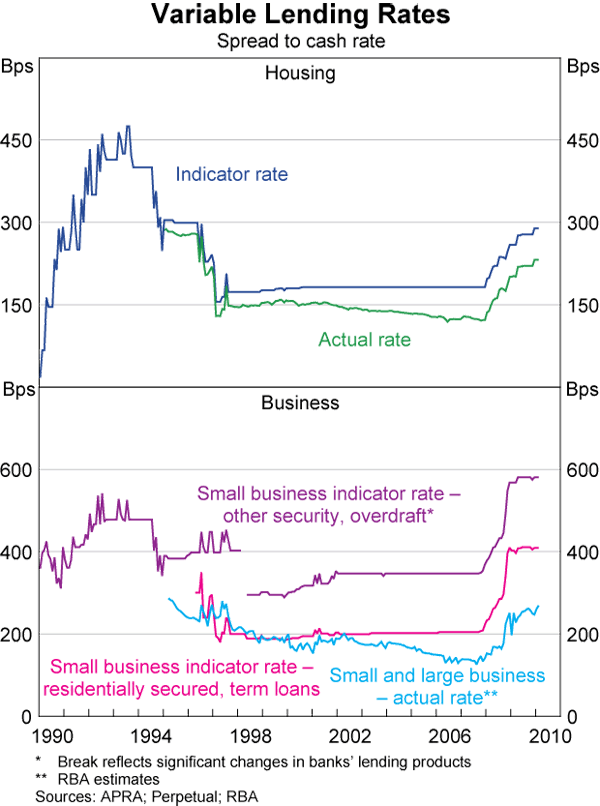
As the global financial crisis unfolded, banks' lending rates have risen relative to the cash rate, reflecting their higher funding costs. The banks have raised their lending rates relative to the cash rate for all of their loan products. The sizes of the increases have varied considerably across the different loan types, however, reflecting factors such as changes in the banks' perceptions of the riskiness of the borrower, the speed at which loans can be repriced, and the sensitivity of the borrower to changes in lending rates. While lending rates often do differ between the banks, for equivalent products neither the major banks nor other banks have materially higher or lower lending rates.
The average rate on outstanding (fixed and variable-rate) housing loans has increased by around 145 basis points relative to the cash rate since mid 2007. Rates on variable housing loans have increased by around 110 basis points over this period (Graph 9). Spreads on the major banks' new 3- and 5-year fixed-rate housing loans have risen by 170–180 basis points relative to equivalent maturity swap rates (and by more relative to the cash rate because of the current slope of the yield curve).
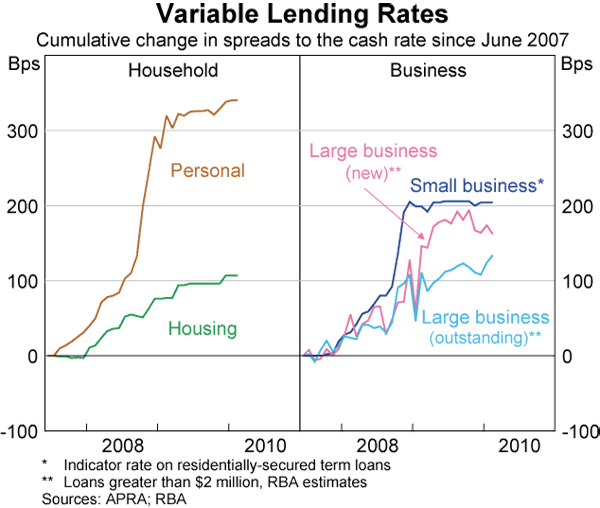
Personal and business loans have had larger increases. For personal loans, interest rates have risen by 340 basis points relative to the cash rate since mid 2007. This significant increase partly reflects the fact that banks' arrears and losses on personal loans have risen more quickly than on their housing loans.
The major banks' variable indicator rates on small business lending have risen by around 200 basis points relative to the cash rate since mid 2007, and some individual borrowers may also have faced additional increases in risk margins.[6] The higher indicator rates have flowed through immediately to new and existing loans. For fixed-rate loans to small businesses, which account for about one-third of outstanding lending, spreads over swap rates on new loans have generally risen by 140–160 basis points. Overall, interest rates on outstanding (fixed and variable-rate) loans to small businesses have increased by about 200 basis points relative to the cash rate since mid 2007.
There can be considerable variation in interest rates across large businesses, as banks base their pricing on the characteristics of the individual borrower. Banks have increased their spreads (over bank bill rates) on new loans (including refinancings) over the past two years, due to their higher funding costs and a pick-up in arrears and losses on business lending as the Australian economy slowed. The available evidence suggests that the average spreads on new term loans to large businesses increased by about 200 basis points from around 50–100 basis points in mid 2007 to a peak of around 250–300 basis points in mid 2009. Since then, spreads have declined a little. These higher spreads have been gradually flowing through to the stock of outstanding large business loans – since mid 2007, banks have repriced about two-thirds of their outstanding loans. Overall, the average interest rate on outstanding (fixed- and variable-rate) large business loans is estimated to have risen by about 135 basis points relative to the cash rate since mid 2007. This is less than the increase on small business loans because a bigger share of large business loans are at variable rather than fixed rates and, to date, not all outstanding loans have been repriced at the higher spreads.
Overall, the major banks' average interest rate on their outstanding household and business loans is estimated to be around 160–165 basis points higher relative to the cash rate, than it was in mid 2007. This overall rise is at the lower end of the range of increases in the main loan types, as through the crisis period, the share of housing loans (which have lower spreads) in the major banks' overall loan books has increased and the shares of business and personal loans have decreased a little.[7] Regional banks have likely recorded a slightly smaller increase in their average lending rate, as more of their lending is for housing. Most of the increases in the spreads between household and business lending rates and the cash rate took place during 2008 and in the early months of 2009, when the global financial crisis was at its worst and banks were facing increasing funding cost pressures.
For all banks, most of the increase in their lending rates over the cash rate since mid 2007 has been due to their higher funding costs. For the major banks, however, there has also been some widening in their lending margins. Information published by the major banks in their financial statements shows that the average NIM on their Australian operations was around 2.4 per cent in the second half of 2009, about 20–25 basis points above pre-crisis levels (Graph 10).[8]
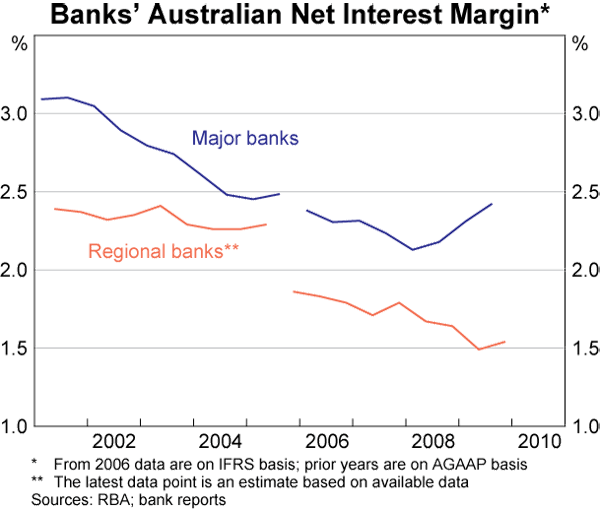
The major banks' higher NIMs have supported their return on equity, partly offsetting the negative effects of the cyclical increase in their bad debts expense and the additional equity that they raised during the downturn. In recent months, margins may have narrowed slightly, due to the ongoing strong competition for deposits and a small decline in spreads on new lending to large businesses.
The regional banks' NIMs have declined steadily for most of the crisis period, though in the latest half-year there have been some signs that their NIMs have risen a little. In the six months to December 2009 the regional banks' average NIM was around 1.6 per cent, about 20 basis points lower than in mid 2007. The narrowing in the regional banks' average NIM is due to their overall funding costs having risen by more than the major banks, and their overall lending rates having risen by a little less, reflecting differences in their lending mix.
Footnotes
The authors are from Domestic Markets Department. [*]
Most data in this latest article are until end February 2010. The previous article is Davies, Naughtin and Wong (2009). [1]
For more details on banks' bond issuance see Black, Brassil and Hack (2010), and for details on the Government wholesale funding guarantee see Schwartz (2010). [2]
The contractual maturity of term deposits (which is generally between 3 and 12 months, but can be as long as 5 years) is longer than the contractual maturity of at-call deposits (effectively 1 day). However, there is likely to be much less difference in the behavioural maturities of term and at-call deposits, as banks normally allow depositors to redeem their term deposits early by paying a break fee and/or forfeiting some accrued interest, and it is easier for depositors to switch their term deposits between banks as they are discrete investments whereas at-call accounts are more ongoing in nature. [3]
The swap rate is the base interest rate for most fixed-rate debt in Australia. It is the fixed rate that one party is willing to pay in exchange for receiving the average bank bill rate over the term of the swap. See Appendix A of Davies et al (2009) for a detailed description of the costs of hedging foreign currency debt liabilities back into Australian dollars using cross-currency interest rate swaps. [4]
For a detailed discussion on developments in the Australian securitisation market, see Debelle (2009). [5]
The higher risk margins apply mainly to non-residentially secured loans. For residentially secured loans, which account for the bulk of lending to small businesses, additional risk margins are generally not applied. [6]
Business credit grew steadily until late 2008, but over the past year many businesses have sought to reduce their leverage by raising equity to pay down debt. For more details see Black, Kirkwood and Shah Idil (2009). [7]
The major banks' published NIM measure includes the interest received on their total financial assets (loans, liquid assets and other debt securities), not just their loan assets, which is the focus of the analysis in this article. [8]
References
Black S, A Brassil and M Hack (2010), ‘Recent Trends in Australian Banks' Bond Issuance’, RBA Bulletin, March, pp 27–33.
Black S, J Kirkwood and S Shah Idil (2009), ‘Australian Corporates' Sources and Uses of Funds’, RBA Bulletin, October, pp 1–12.
Davies M, C Naughtin and A Wong (2009), ‘The Impact of the Capital Market Turbulence on Banks' Funding Costs’, RBA Bulletin, June, pp 1–13.
Debelle G (2009), ‘Whither Securitisation?’, RBA Bulletin, December, pp 44–53.
Schwartz C (2010), ‘The Australian Government Guarantee Scheme’, RBA Bulletin, March, pp 19–26.